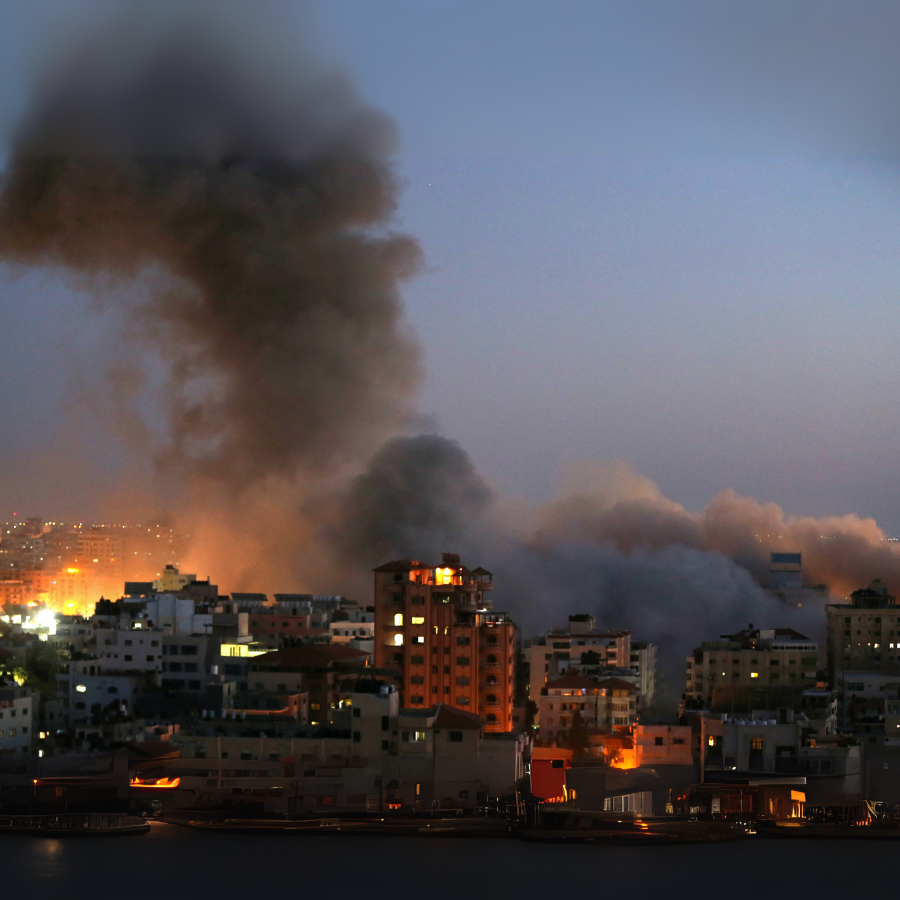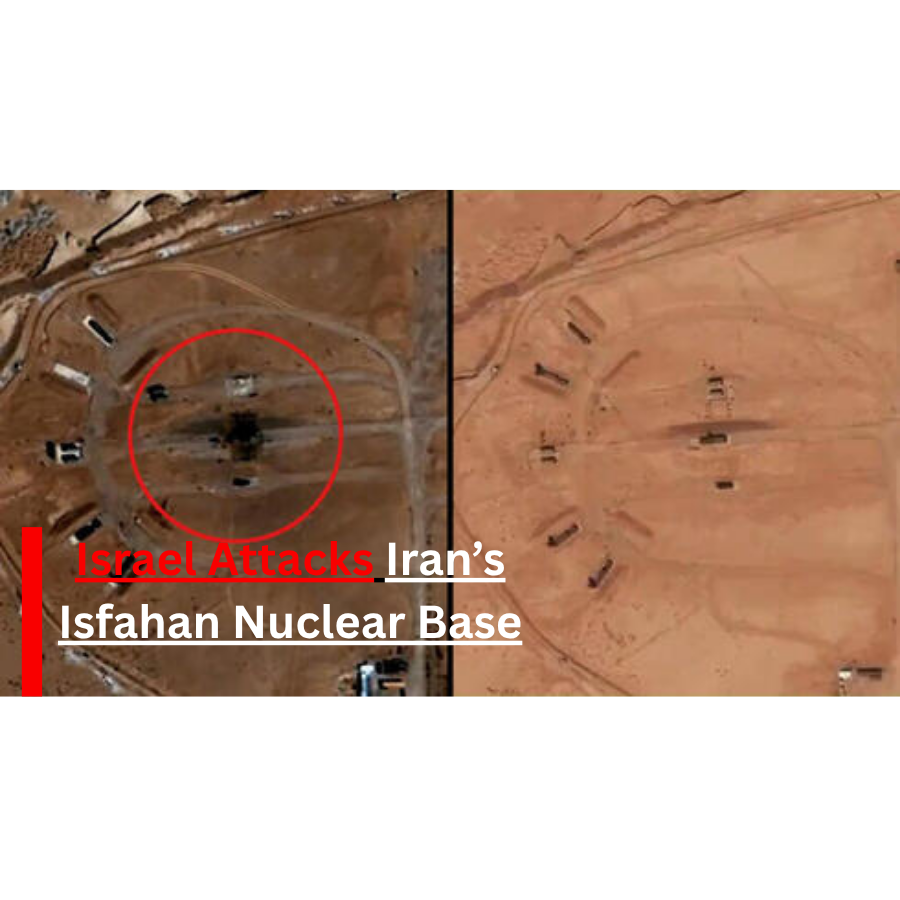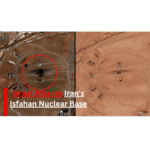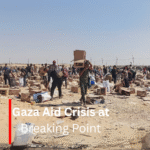Now Reading: Gaza Aid Crisis Deepens: 23 Civilians Killed Near Food Distribution Site Amid Escalating Conflict
-
01
Gaza Aid Crisis Deepens: 23 Civilians Killed Near Food Distribution Site Amid Escalating Conflict
Gaza Aid Crisis Deepens: 23 Civilians Killed Near Food Distribution Site Amid Escalating Conflict

By Ahsan, Brainstak.com Contributor
Gaza Aid Crisis Turns Deadly at Food Distribution Site
Palestinian men carry a wounded civilian after Israeli troops opened fire near a food aid distribution site in Rafah, southern Gaza aljazeera.comgov.za. Witnesses and medics say Israeli forces fired on a crowd of thousands of desperate people who had gathered to receive humanitarian aid, killing at least 23 Palestinians on the spot and wounding dozens more gov.zagov.za. The Hamas-run Gaza Health Ministry later updated the death toll to 31 as more victims succumbed to their injuries gov.za. Among the dead were women and young people who had been waiting in line for flour and basic supplies.
Amid the deepening Gaza aid crisis, the Israel Defense Forces (IDF) acknowledged its troops were operating in the area and had fired “evasive shots” when a large crowd approached, but said soldiers only targeted individuals deemed to pose a threat theguardian.com. According to an IDF statement, warning shots were fired and, after some in the crowd did not disperse, “additional shots were fired near the individual suspects who were advancing towards the forces” theguardian.com. The military said it “regrets any harm to uninvolved individuals” and claims it tries to minimize civilian casualties reuters.com. However, survivors dispute the IDF’s account – one eyewitness told Reuters that “shells started falling” without warning as people rushed forward hoping to collect food, leaving bodies torn apart on the ground reuters.com. “People are dying, being torn apart, just trying to get flour to feed their children,” the witness said in anguish reuters.com.

This bloody incident near the aid site is not an isolated case, but part of a disturbing pattern. It marks the latest in near-daily shootings at food distribution centers across Gaza, a phenomenon that has left hundreds dead in recent weeks sepe.grsepe.gr. Scenes of chaos and grief have unfolded repeatedly: bereaved families mourn over the shrouded bodies of relatives killed while waiting for food, and hospitals inundated with gunshot victims struggle to cope theguardian.comreuters.com. For many Gaza civilians, venturing out to grab a sack of flour or a box of canned goods has become a potential death sentence.
Humanitarian Disaster Gaza: Aid System Collapse and Deadly Shortages

Crowds of displaced Palestinians gather with carts and bicycles to haul away food aid supplies in Gaza, illustrating the massive humanitarian need and chaos at distribution sites aljazeera.com. The humanitarian disaster in Gaza has escalated to a breaking point, with the Gaza aid crisis now defined by daily violence, starvation, and desperation at aid sites. Over 2 million residents of the densely populated Gaza Strip are now relying on trickles of humanitarian aid to survive, amid what aid agencies call an unprecedented humanitarian disaster. Food, clean water, medicine, and fuel are all in short supply, contributing to what many are now calling a full-scale humanitarian disaster Gaza cannot recover from without intervention. The United Nations reports that malnutrition and hunger are soaring, with a “very limited” amount of food entering Gaza under tightly controlled conditions wutqfm.comwutqfm.com. Long queues of families form daily at distribution sites, and many say they must choose between starvation or risking death as they approach these aid points guarded by armed forces aljazeera.comaljazeera.com.
The distribution of basic supplies in war-torn Gaza has become fraught and perilous, exacerbating the territory’s deep hunger crisis theguardian.com. In late May 2025, Israel and the United States backed the launch of a new aid distribution mechanism known as the Gaza Humanitarian Foundation (GHF), which took over food deliveries from the UN. The GHF set up a few large aid centers in Gaza, but these sites are in areas tightly controlled by the Israeli military aljazeera.comaljazeera.com. Critics say the new system has militarized aid distribution, removing neutral agencies like the U.N. Relief and Works Agency (UNRWA) that previously oversaw humanitarian operations gov.zatheguardian.com. UN agencies and major NGOs warn that the GHF approach cannot meet the needs of Gaza’s 2.3 million residents and “turns food into a weapon” to control the population aljazeera.comtheguardian.com. Indeed, the government of South Africa condemned the marginalization of UNRWA and the handover of aid to military-linked groups, calling it a form of collective punishment that deepens the catastrophe in Gaza gov.zagov.za.

Humanitarian observers note that since the GHF centers opened, violent incidents at aid sites have skyrocketed. The International Committee of the Red Cross (ICRC) said Gaza’s health system is “extremely fragile” as it struggles with a surge of trauma patients from these shootings aljazeera.comaljazeera.com. In a single two-week span in early June, the Red Cross Field Hospital in Rafah had to activate mass-casualty emergency protocols 12 times, receiving waves of people with gunshot and shrapnel wounds from aid distribution areas aljazeera.com. “An overwhelming majority of patients from the recent incidents said they had been trying to reach assistance distribution sites,” the ICRC reported aljazeera.com. By mid-June 2025, local officials in Gaza tallied over 300 civilians killed and more than 2,000 wounded at or near food hubs since the new aid system began on May 27 aljazeera.comaljazeera.com. Each day seems to bring new casualties: mothers, fathers, and children cut down by bullets or tank fire as they simply queue for life-saving supplies. This deadly chaos prompted some observers to label the distribution centers “human slaughterhouses” and spurred calls for their immediate suspension until civilian safety can be assured aljazeera.comaljazeera.com.
Mounting Gaza Civilian Deaths Amid Hamas-Israel Conflict

These tragedies are unfolding against the backdrop of an expanded and intensifying Hamas-Israel conflict, now coupled with worsening humanitarian conditions across the Gaza Strip. now further intensified by a relentless Gaza aid crisis that’s costing civilian lives daily. Sometimes referred to as the Gaza war of 2025, which has raged on for over a year and a half. Since Hamas’s brutal attack on Israel in October 2023 and the subsequent Israeli military offensive, Gaza has been under constant bombardment and siege. Israeli airstrikes (Israeli airstrikes are a near-daily occurrence) have leveled entire neighborhoods, and intensive ground battles have displaced roughly three-quarters of Gaza’s population into crowded shelters in the south. The civilian death toll in Gaza has climbed to staggering heights. According to Gaza’s Health Ministry, Israeli assaults, including near-daily Israeli airstrikes, have killed over 55,000 Palestinians and injured more than 128,000 since the war began. aljazeera.com. Independent observers say the vast majority of those killed have been civilians, including thousands of women and children, as Gaza civilian deaths continue to climb to devastating levels. (By comparison, around 1,100 people were killed on the Israeli side during Hamas’s initial attacks, along with over 200 taken hostage. aljazeera.com.)
The recent escalation in the Hamas-Israel conflict has not been limited to Gaza alone. Israeli airstrikes targeting Ayatollah Khamenei’s bunker in Tehran reflect the growing regional dimension of the crisis, raising fears of a wider Middle East confrontation while humanitarian suffering in Gaza continues unchecked.

Israeli officials insist that Hamas fighters are intermingling with the civilian population and even accuse Hamas of exploiting aid distributions as cover – allegations Hamas denies. In March 2025, Israel completely cut off all aid deliveries for eleven weeks, claiming Hamas was seizing supplies for its militants theguardian.com. Food stocks in Gaza dwindled to almost nothing during that period, bringing parts of the enclave to the brink of famine. Under intense international pressure, Israel then allowed the limited GHF operation to start, rather than restoring the U.N.’s relief channels theguardian.com. However, the resumption of aid came with deadly strings attached: Palestinians must travel to designated hubs and often traverse combat zones to get there, as the Israeli army has declared areas around aid routes to be “combat zones” off-limits to civilians theguardian.com. In effect, civilians are being forced into harm’s way to obtain food. “Going back to the aid distribution is a huge risk and a potential death sentence, but everyone who went had no other choice,” said one man who lost a relative to the recent shootings. “If they aren’t killed by bullets or shelling, they will die of hunger” theguardian.comtheguardian.com.
The past month has seen some of the deadliest days of the war. In one incident on June 17, at least 59 people were killed when Israeli tanks opened fire on a gathering of civilians around a stalled aid truck near Khan Younis reuters.comreuters.com. Video from that scene showed gruesome images of bodies torn apart on a roadway. Medics say it was the single worst massacre since limited aid deliveries resumed, with over 220 others wounded in that strike alone reuters.com. The following day, another burst of gunfire and airstrikes killed 14 more people across Gaza, including several at aid queues reuters.com. In early June, in a three-day span, Israeli troops shot dead over 80 people who were attempting to reach food distribution points theguardian.comtheguardian.com. The Israeli military for the first time admitted to these shootings, asserting that soldiers had identified “suspects” in the crowds theguardian.com. Nevertheless, Palestinian officials and international observers argue that nothing can justify the carnage being inflicted on unarmed civilians in need. The UN Office of the High Commissioner for Human Rights declared that even if there are security concerns, “deadly attacks on distraught civilians trying to access the paltry amounts of food aid in Gaza are unconscionable”, stressing that people cannot be denied their right to life-sustaining aid theguardian.com.
International Reactions: Condemnation and Calls for Accountability

The escalating violence at Gaza’s aid distribution sites has prompted widespread international outrage and warnings of potential war crimes. Volker Türk, the United Nations High Commissioner for Human Rights, condemned the repeated killings of civilians around aid centers in unequivocal terms. “Deadly attacks on distraught civilians trying to access the paltry amounts of food aid in Gaza are unconscionable,” Türk said, calling such attacks “a grave breach of international law and a war crime”theguardian.com. He urged Israel to uphold its obligations under the Geneva Conventions to protect civilians and ensure they have safe access to relief. Similarly, a panel of U.N. human rights experts cautioned that impeding humanitarian aid and targeting starving civilians could amount to war crimes, and they implored world governments to “stop the clock on this madness” by pressuring Israel to halt the bloodshed x.comarabnews.com.
Global humanitarian organizations echo these concerns. The International Committee of the Red Cross has urged respect for civilian life and the sanctity of humanitarian operations. The ICRC’s regional director warned that Gaza’s remaining hospitals are overwhelmed and that further loss of life is inevitable without urgent action to protect both patients and aid-seekersaljazeera.comaljazeera.com. “To avert preventable deaths, the services of the remaining healthcare facilities must be preserved and reinforced,” the Red Cross emphasized, noting that medical teams are struggling to treat the flood of gunshot wounds from aid site incidentsaljazeera.comaljazeera.com. International NGOs like Doctors Without Borders (MSF) have also spoken out: an MSF coordinator blasted the current aid scheme as “neither a humanitarian enterprise nor a system – this is basically lethal chaos”, accusing Israel of using food as a tool for forcible displacement of Gazansaljazeera.comaljazeera.com.
Several foreign governments have condemned the violence and called for accountability. Notably, South Africa’s government – a vocal advocate for Palestinian rights – said it was “gravely alarmed” by confirmed reports of Israeli forces gunning down civilians at an aid pointgov.zagov.za. Pretoria’s foreign ministry noted that many victims had been shot in the head and chest while simply trying to collect food, and it demanded an “immediate, impartial international investigation” into the incidentgov.zagov.za. “Israel, as the occupying power, bears legal responsibility under international humanitarian law for the protection of civilians and to ensure safe access to aid,” the South African statement declared, denouncing the killings as a flagrant breach of the Geneva Conventionsgov.zagov.za. Other nations in the global South and Middle East have issued similar denunciations, with calls in some quarters to hold Israeli officials accountable in international courts. There is a growing clamor for concrete measures – from arms embargoes to war crimes prosecutions – to deter further atrocities. Even traditional Western allies of Israel have urged restraint: for instance, the European Union and United States have both pressed the Israeli government to minimize civilian harm and facilitate more humanitarian aid, though critics say these appeals have been too muted and often couched with support for Israel’s “security concerns.”

The United Nations Security Council has convened multiple emergency sessions on Gaza’s humanitarian nightmare. While resolutions demanding ceasefires or greater aid access have been repeatedly vetoed or ignored, U.N. officials continue to push for at least humanitarian pauses to allow relief convoys through. As of June 2025, limited U.N.-supervised deliveries have finally begun alongside the GHF program – including World Food Programme trucks entering via newly opened corridorstheguardian.com – but these are nowhere near enough to meet the colossal needs. The World Food Programme warns that over 500,000 Gazans are on the verge of starvation, and the Integrated Food Security Phase Classification (IPC) system has raised Gaza’s alert to the highest level, indicating an imminent risk of faminegov.za. International law explicitly forbids the use of starvation as a weapon of war, yet Gaza’s civilians are effectively being strangled by the blockade and sporadic aid distribution violencegov.zagov.za.
Conclusion: A Plea for Safe Passage and Humanity
Nearly twenty months into this conflict, the situation in Gaza is nothing short of catastrophic. Families who have lost everything in the bombings now also fear being shot dead as they queue for a loaf of bread or a sack of flour. The humanitarian disaster in Gaza underscores a fundamental point: access to food and medicine must never become a death-defying endeavor. As one Palestinian aid-seeker bluntly put it, people in Gaza are “hopeless, starving, and besieged” – they feel abandoned by the world while being forced to risk their lives for basic sustenancemissouriindependent.comaljazeera.com.

International observers stress that urgent steps are needed to prevent further loss of life. These include guaranteeing safe zones and corridors for aid distribution, deploying neutral monitors, and restoring the U.N.’s leading role in humanitarian operations. There are growing calls for a durable ceasefire in the Hamas-Israel conflict to allow a full humanitarian relief effort and to spare Gaza’s civilians from more bloodshed. Thus far, however, diplomatic efforts have fallen short, and the violence continues unabated.
In the meantime, the U.N., Red Cross, and dozens of aid agencies have appealed to Israel to honor its obligations to protect civilians and facilitate unhindered aid deliverygov.zagov.za. They also urge Hamas and other armed groups to respect humanitarian principles and not carry out any actions that would endanger civilians at aid sites. The stakes could not be higher: without a drastic change in approach, Gaza’s most vulnerable – the elderly, the sick, and the children – will continue to pay for this war with their lives. The world is watching events at Gaza’s food distribution lines with growing horror. For the sake of innocent civilians, the violence at aid sites must stop, and lifesaving relief must be allowed to flow freelytheguardian.comgov.za. Anything less will deepen an already colossal tragedy and tarnish our collective conscience.
Sources: Recent news reports and official statements from BBC News, Reuters, Al Jazeera, The Guardian, Associated Press, United Nations, ICRC, and othersgov.zatheguardian.comaljazeera.comaljazeera.com. These sources document the events and international reactions as of June 2025, highlighting the urgent need for humanitarian protection in Gaza. All information has been verified for accuracy and presented in a neutral, factual manner.

























